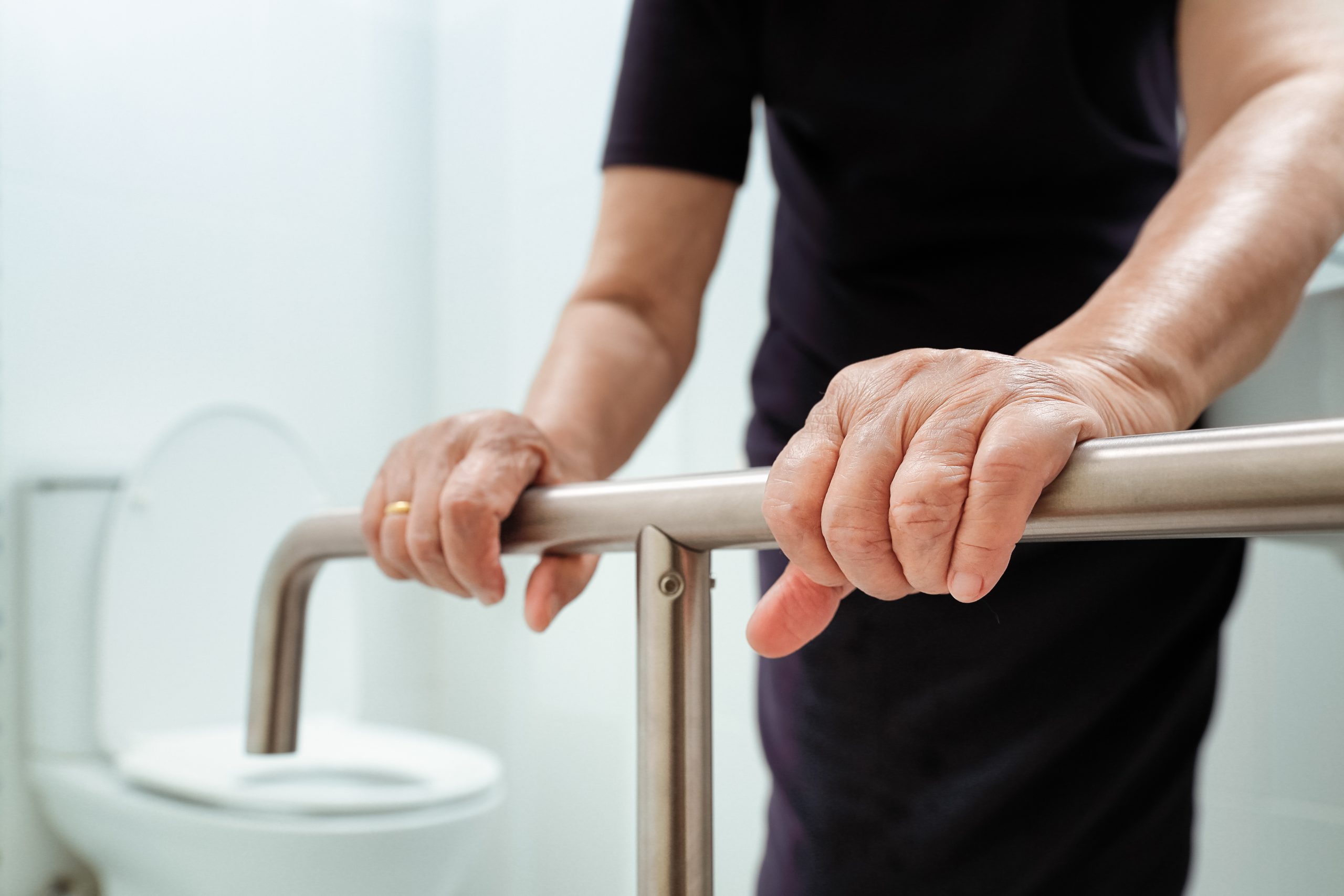ADA Toilet Design for Accessibility, Functionality, and More

When developing an ADA toilet design, it’s important to consider not just the toilet itself, but also the surrounding space and accessories. This includes guaranteeing proper clearances for wheelchair users, installing grab bars at the correct height and position, and providing easily operable flush controls. Complying with the Americans with Disabilities Act is imperative.
While these are federal guidelines, local codes may have additional or more stringent requirements. It’s always advisable to check local regulations as well.
Accessibility standards are like the guardrails on a winding road: essential for safety, but not the destination itself. They establish essential minimum dimensions and requirements, acting as the legal, design, and construction baseline. However, it’s wise to surpass these minimums whenever possible.
Designing and building solely to the bare minimum is a risky game, and it could leave the facility vulnerable to non-compliance. It’s like constructing an edifice just strong enough to stand. It may be functional, but it’s not resilient in the face of unexpected challenges.
“To be ADA-compliant, these toilet rooms must follow exact measurements for toilet compartment doors, faucets, flush valves, grab bars and soap dispensers, as well as having a floor clearance of 60 inches for turning space,” states one expert’s column in HuffPost. “In reality, most people will either have a disability or know someone with one.”
One in four people living in the United States currently have a disability, it adds. “That percentage increases to two in five for American adults 65 years and older, according to the Centers for Disease Control and Prevention.”
This has huge current and future implications for your organization’s restroom facilities and toilet designs.
Consider Height, Space, and Convenience with ADA Toilet Design
Guidelines for accessible restrooms and ADA toilet design aren’t just legal hoops to jump through; they’re a blueprint for inclusivity. By embracing these standards, you’re not only complying with the law but also creating a welcoming space for everyone.
Imagine a spacious restroom where a wheelchair can easily twirl, thanks to a 60-inch diameter turning circle. The 30-inch by 48-inch clear path leading to the toilet is a smooth entrance. Fortunately, it’s not cramped.
ADA-compliant toilets offer ample legroom and maneuvering space. Whether it’s a 17 to 19 inch comfort-height seat for easy transfers or a wall-mounted seat that frees up floor space, these designs prioritize convenience and independence. The 9-inch toe clearance under the toilet ensures wheelchair footrests have plenty of room, allowing users to get close and comfortable.
Grab bars offer support and stability. Strategically placed on the side and back walls, these bars empower users to navigate the restroom with confidence.
Looks can be deceiving these days. Some users find that even toilets with a comfort-height label might not actually meet the 17-inch minimum in certain public restrooms. Additionally, multi-user restrooms should have at least one designated wheelchair-accessible stall, complete with specific dimensions and outward-swinging doors for easy access.
By going beyond the minimum requirements, you can create a restroom experience that’s welcoming, dignified, and accessible for all. For instance, an automatic or sensor-activated flush offers a touchless experience. Whether it’s little or big conveniences, this is about more than just compliance; it’s about fostering an inclusive environment where everyone feels valued and respected.
Toilet Type, Compartments, Door Swing, and Signage
ADA toilet design guidelines favor undercut or wall-mounted toilets, offering more legroom and space to maneuver. Wall-mounted thrones are especially helpful for toe clearance, creating a welcoming space underneath. Undercut bowls, with their open space at the bottom, offer another accessible option.
In shared restrooms, at least one stall must be a wheelchair-accessible haven. If the stall walls lack toe space, think even grander dimensions: 62 or 65 inches deep and 66 inches wide. For those not using wheelchairs, smaller ambulatory stalls, at least 60 inches deep and 35 to 37 inches wide, can be offered.
No doors should impede the path to the toilet. Compartment doors, like all doors, must swing clear of the required floor space. In shared restrooms, doors should swing outward to preserve stall space.
For private restrooms, a push-exit door usually needs a 48-inch by 12-inch clearance, while a pull-exit door usually requires a 60-inch by 18-inch space. All stall doors should be at least 32 inches wide and self-close smoothly and quickly.
To guide guests to their rightful destination, accessible restrooms must be clearly marked. This can include raised characters, Braille, and the iconic International Symbol of Accessibility (ISA), also known as the blue-and-white square Wheelchair Symbol. If not all of your organization’s restrooms are accessible, the ones that are should proudly display the ISA logo.
The symbol can be on the restroom sign or separate. If pictograms are used, which are symbols for men’s, women’s, or unisex restrooms, the ISA symbol should be at least 6 inches high with raised characters and Braille below. If renovations make existing restrooms non-compliant, signs with the ISA must direct users to the nearest accessible toilet.
How ADA Toilet Design is Embedded in Restroom Accessibility
By following these ADA toilet design guidelines, you’ll create a restroom fit for royalty, where everyone can feel comfortable and confident. Accessibility is not just about compliance, it’s about creating a space where everyone feels welcome. You can create a restroom fit for all, ensuring everyone can enjoy a comfortable and dignified experience.
“Though everyone is different, over three million people have difficulty using the bathroom,” states an article in House Digest regarding accessibility in residential homes. “Accessible bathrooms reduce the risk of injury and facilitate independence.”
It adds: “However, when people think of accessible features, style isn’t always the first word to come to mind. No one wants their home bathroom to look like it belongs in a hospital. Instead, it should feel like it goes with the rest of the home.”
Perhaps the same can be said about commercial and public buildings. According to the article, HGTV’s Christina Hall has recently woven together beauty and accessibility in a breathtaking bathroom remodel for a client with limited mobility. This is not merely a renovation; it’s a testament to the belief that everyone deserves a space that is functional.
The bathroom mentioned in the article has been reborn as a sanctuary of style and ease. Hall listened intently to her client’s needs, weaving them into every aspect of the design. The result is a masterpiece that transcends mere functionality, embracing the client’s lifestyle with grace and elegance.
This design seamlessly integrates features that are embedded into the very fabric of the restroom, ensuring it feels like a retreat. Hall’s creation is a testament to the power of design to improve lives.
It’s a reminder that accessibility doesn’t have to be synonymous with compromise. Beauty and functionality can coexist, even in a commercial or public restroom.
Accessibility Isn’t Just About Checking a Box
Accessibility in ADA toilet design and other restroom functionality challenges and opportunities isn’t just a box to be checked; it’s a journey toward a more welcoming world.
After a recent complaint in Illinois revealed that a hotel failed to provide accessible rooms as promised, an investigation uncovered a lack of ADA-compliant rooms and several existing rooms with accessibility barriers. According to the Springfield State Journal-Register, the hotel’s owners had to agree to a major makeover. It culminated in a U.S. Justice Department settlement agreement that promises a more welcoming experience for guests with disabilities.
“The department received a complaint from a person with a disability, alleging a room they had reserved did not have toilet handrails or an accessible shower,” the article states. “The hotel provided the complainant a second room, but it too lacked toilet handrails, had a broken toilet seat hinge, and an inaccessible shower.”
Going forward, 11 new accessible rooms will be added to the hotel’s inventory, while existing rooms will be upgraded to eliminate barriers. This transformation aims to ensure all guests can enjoy a comfortable and independent stay regardless of their abilities. Traveling shouldn’t be a struggle for independence, attorneys for the Justice Department argued in the case.
This settlement marks a victory for accessibility and is a reminder that it’s not just a legal requirement; it’s a fundamental right for travelers depending on the state. Going beyond minimum requirements in toilet design and other accessibility creates spaces that truly empower everyone. By exceeding expectations, you not only ensure compliance but also create a legacy.
American Specialties, Inc.
American Specialties, Inc. (ASI) fine-tunes your ADA toilet design so your business or organization can comply with Americans with Disabilities Act regulations. For customers who demand high-quality, innovative products, ASI offers a complete collection of commercial washroom equipment.
Additionally, ASI Group designs, engineers, and manufactures from a single source. This includes fully integrated washroom accessories, partitions, lockers, and visual display products. It’s just the beginning of what ASI has to offer.

